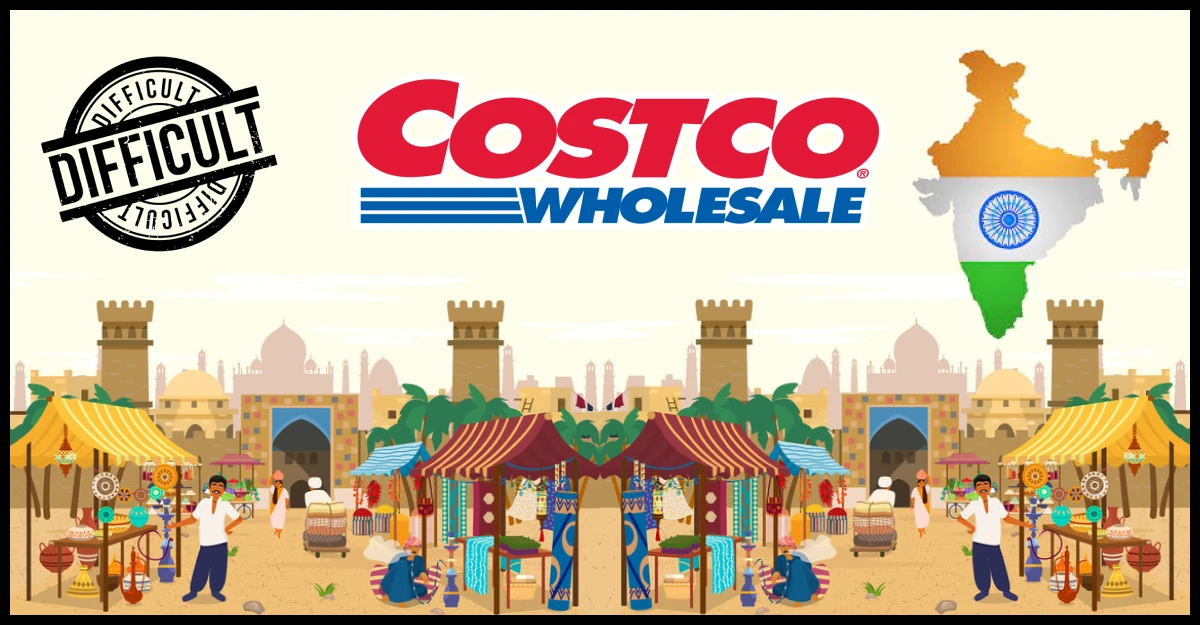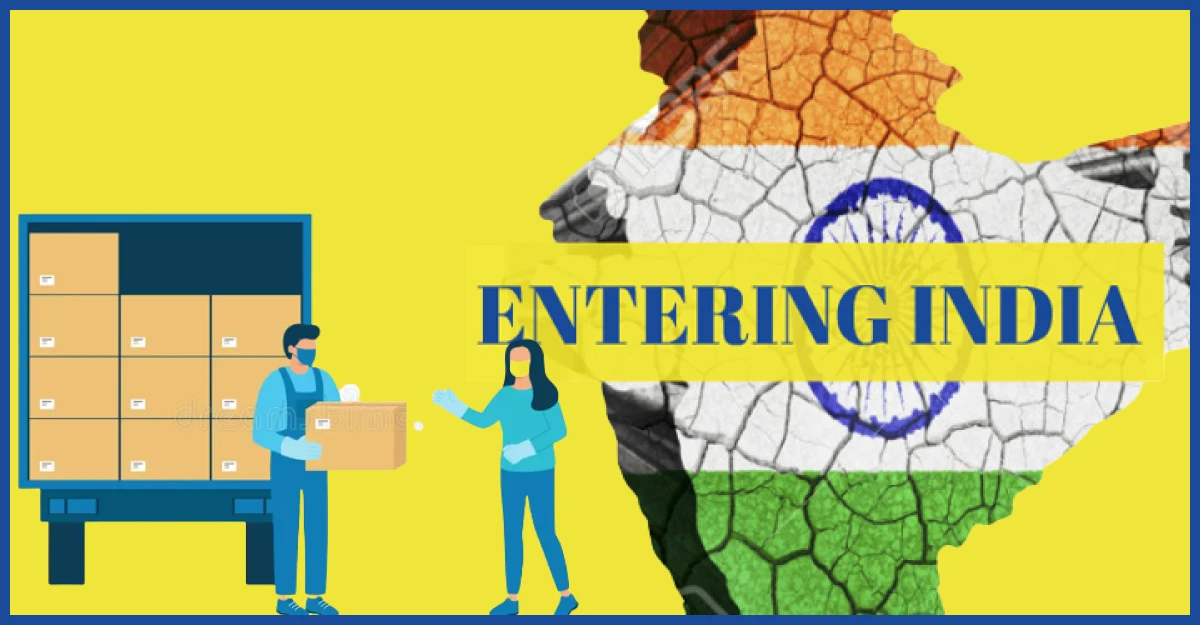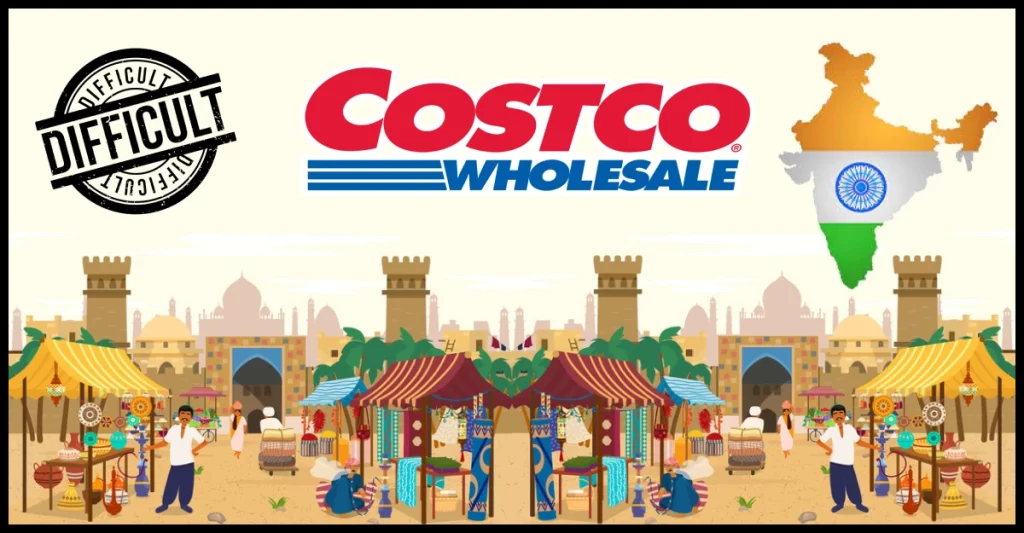In the West, if you ask an individual about the best wholesale store with an alluring discount, Costco would be the most common answer. Reason? Costco is the favorite destination for shoppers who prefer good quality products at heavy discounts.
Costco, a renowned American wholesale retailer has already spread its wings to Australia, Europe, and East Asia.
But the surprising fact is- How could it miss a booming market i.e. India? Did it miss on purpose or is Costco unable to enter India? Well, the latter is true! Why is Costco unable to enter India? Well, it faced several challenges in its quest to enter the Indian market.

What are the challenges faced by Costco? You may ask. Stick to this article and you will find out soon!
1. FDI (Foreign Direct Investment) Regulations
In India, there are strict rules for big foreign stores like Costco if they want to sell many brands under one roof.
India has stringent FDI regulations for multi-brand retail trading (MBRT). These regulations impose conditions on foreign retailers, including Costco. Fresh agricultural produce, such as fruits, vegetables, grains, and meat, must be unbranded to be eligible for FDI in MBRT.
Sounds complicated? Let me explain in simple terms.
These rules, especially for selling fresh food like fruits, vegetables, and meat, say these products cannot have the foreign store’s brand name on them.
Instead, they must be sold without any fancy labels or names they might usually have.
Why?
Well, it’s all about fairness. India wants to make sure that local farmers and small shops still have a fair chance to compete with these big foreign stores. By preventing the big stores from putting their brand names on fresh produce, the government aims to level the playing field.
They don’t want one big company to have too much control over what gets sold and at what price.
So, these rules are put in place to protect local businesses and ensure fair competition in the marketplace. It’s like making sure everyone gets an equal opportunity to succeed, regardless of their size or where they’re from.
This is the prime reason for- why is Costco unable to enter India.
2. Unorganized Retail Landscape
In India, most of the retail stores are small, family-owned businesses, local markets, or traditional bazaars. These places are what we call “unorganized,” meaning they don’t follow a strict structure like big supermarkets do.
They might have a bit of everything, from groceries to household items, all mixed together.
Now, here comes Costco, with its massive warehouses where they sell things in huge quantities. But here’s the catch- this setup doesn’t really fit with how things work in India.
Indian shoppers are used to a more organized and specialized shopping experience. They like going to stores where things are neatly arranged, and they can find exactly what they need without wandering around huge aisles.
So, Costco’s big, sprawling warehouses filled with stuff all over the place are quite different from what Indian consumers are used to. It’s like trying to fit a square box into a triangle setup.
In short, Costo doesn’t quite match up with what people here are looking for when they go shopping.
3. Real Estate Challenges (Costco unable to enter India)
Finding the right places to build Costco’s huge warehouses in India is a big challenge. You see, there aren’t many perfect spots available, especially in the best areas where lots of people shop.
Plus, buying land can be really tricky and take a long time because there are a lot of rules and regulations to follow. And even if they do find a good spot, it can cost a ton of money because land prices are so high, especially in popular areas.
On top of all that, there are rules about what kind of buildings can go where which can make it even harder for foreign stores like Costco to set up shop.
So basically, it’s a real headache trying to find the right place to build these massive warehouses, and there are a bunch of obstacles standing in the way, like finding the right spot, dealing with all the rules, and paying for the land.
The zoning restrictions further complicate matters for foreign retailers…
4. Supply Chain and Distribution Infrastructure
India’s supply chain infrastructure presents a huge bundle of challenges, particularly in transportation, logistics, and distribution. You see, Costco needs to invest a lot of money to efficiently manage its extensive network of suppliers and ensure timely delivery to its warehouses across the country.
By the way, Costco must have invested in other regions too like Australia and Europe during its expansion.
Then how come this sort of investment emerged as a challenge for Costco in India?
Due to the following reasons-
(4.1) Transportation
Firstly, transportation poses a challenge due to-
- Varying road conditions
- Traffic Congestion
- Inadequate infrastructure
If you have ever visited India thoroughly through its towns, cities, and villages, you would understand why transportation is such a great challenge.
Moving goods from suppliers to Costco’s warehouses requires navigating through these obstacles, which can lead to delays and increased costs. Additionally, India’s vast geographical expanse means that goods may need to travel long distances, further complicating transportation logistics.
(4.2) Logistics
Logistics is another critical aspect. You need sophisticated systems and processes for
- Coordinating the movement of products
- Inventory management
- Optimizing routes for delivery
Managing all this is what we call logistics, and it’s a big deal. It involves keeping track of inventory, finding the best routes for delivery, and making sure everything runs smoothly. But in India, with its complicated market and rules, Costco has to adjust its global logistics plan to fit in.
(4.3) Distribution
Then there’s distribution, which has its problems. India’s diverse consumer preferences and fragmented market make it essential for Costco to tailor its distribution strategy accordingly. Simply, it means that India has a lot of different types of customers with different preferences, and it’s not always easy to reach them all.
Costco has to figure out the best way to get their products to people in cities and also in far-off places. It needs careful planning and investment in infrastructure.
To tackle all these challenges, Costco needs to invest a lot of money and make some changes to how they do things. They have to be smart about where they spend their money and adapt their strategies to fit the Indian market. Only by doing this can Costco make sure their supply chain works well in India.
5. Cultural Differences and Consumer Behavior

Here comes the crucial part that makes the Indian market, one of the toughest markets in the world to crack.
What I mean here is that dealing with Indian customers isn’t a cakewalk.
The majority of Indian consumers prioritize personalized service, enjoy the art of bargaining, and appreciate the convenience of neighborhood shops. You will see such things rarely in the Western world.
After all, Indians want the best product for the price they pay!
This factor is highly contradictory to Costco’s business model. How? Costco’s no-frills, self-service approach may not align well with these ingrained consumer preferences in India.
Let’s dive into the details that make Costco unable to enter the Indian market-
(5.1) Personalized Service & Guidance
See, Indian consumers are highly influenced by their cultural norms and traditions. Consequently, they exhibit unique preferences and purchasing behaviors. This means that Indians value personalized service and interpersonal interactions when shopping.
They seek guidance and assistance from store staff, preferring a more hands-on shopping experience over self-service models.
Costco’s emphasis on efficiency and minimal staffing may not meet the expectations of Indian consumers who value personalized attention.
(5.2) Bargaining
Additionally, bargaining is a common practice in Indian markets, where consumers enjoy negotiating prices to secure the best deal.
Contrarily, Costco offers fixed pricing (although discounted) and follows bulk sales business mode. This factor doesn’t fit with the cultural norm. As a result, Costco has no choice but to skip the bargain-loving consumers who prefer to further lower the price of discounted products.
(5.3) Neighborhood Convenience
Moreover, neighborhood convenience plays a significant role in the shopping habits of Indian consumers. They prefer shopping at local stores within their communities for daily necessities. These factors lead to a sense of familiarity and trust between the retailers and consumers.
Do you think Costco can break this sort of retailer-customer bond?
Of course not!
Another key reason is Costco has a large warehouse format. These are often located outside residential areas, and may not offer the same level of convenience as neighborhood shops.
What Costco must do to thrive in the Indian market?
To succeed in the Indian market, Costco must adapt its business model to resonate with local tastes and preferences. This adaptation could involve the following-
- Incorporating elements of personalized service
- Accommodating bargaining practices
- Exploring more accessible and convenient store locations
By embracing these adjustments, Costco can establish a stronger connection with Indian consumers and enhance its competitiveness in the market.
6. Competition from Existing Players
Do you know, the Indian market is full of cut-throat competition? In India, well-established retailers already have a strong foothold in the wholesale and hypermarket sector. Some of the prominent ones are-
- Reliance Retail
- Big Bazaar
- Metro Cash & Carry
- D-Mart
- V-Mart
To compete effectively with these established players, Costco must develop a distinct value proposition and differentiation strategy. I mean the Indian consumers must get a justified reason for why to shop from Costco and not from the well-established ones.
How Costco can compete with Indian hypermarkets & wholesale retailers?
Here are some of the effective ways that can offer solutions to why is Costco unable to enter the Indian market.
(6.1) Differentiation
Firstly, differentiation is crucial to stand out in a crowded market. Reliance Retail, Big Bazaar, and Metro Cash & Carry have built strong brand identities and loyal customer bases over the years.
Costco must identify areas where it can offer unique value to consumers, whether through product selection, pricing, customer service, or shopping experience.
This could involve leveraging its global sourcing capabilities to offer a diverse range of high-quality products at competitive prices or introducing innovative membership perks tailored to Indian consumers.
(6.2) Understanding the fine distinction of the Indian market
Each of the well-established retailers has adapted its business model to cater to local preferences and market dynamics of India.
Hence, Costco must conduct thorough market research to identify gaps or unmet needs that it can address effectively.
This might involve the following-
- Customizing the product offerings
- Store layouts
- Effective marketing strategies
These moves will help to resonate with Indian consumers’ preferences and buying behaviors.
(6.3) Building Partnerships & Alliances
This is the most effective method adopted by foreign brands to thrive in India. Reason? Building partnerships and alliances can provide Costco with a competitive edge.
Collaborating with local suppliers, manufacturers, or technology providers can help streamline operations, enhance product offerings, and strengthen its market position.
By forging strategic alliances with key stakeholders, Costco can utilize the local expertise and resources to navigate the intricacies of the Indian retail landscape more effectively.
Thus, by carefully strategizing its approach and offering a compelling value proposition to consumers, Costco can carve out a niche for itself in the competitive Indian retail market.
7. Regulatory Compliance and Licensing
Remember the FDI regulations that we talked about in the beginning? That was just the tip of the iceberg!
India’s regulatory landscape is far more complex than you might think. To operate successfully in India, Costco needs to go through-
- Countless licenses
- Permits
- Compliance requirements
- Labor Laws
And the list never ends…
Let’s go through them in detail-
(7.1) Licenses & Permits: A Complicated Process
In India, obtaining the necessary licenses and permits is a complex process. Why? You may wonder.
See, here different states and municipalities may have varying regulations governing retail operations, land use, environmental standards, and food safety. Costco would need to navigate through this regulatory maze, ensuring compliance at every level to avoid legal complications and delays in setting up its operations.
(7.2) Compliance with Labor Laws
Firstly, obtaining the necessary licenses and permits can be a complex process. Different
Moreover, compliance with labor laws is essential to ensure fair and ethical employment practices. India has strict regulations concerning the following-
- Wages
- Working Hours
- Employee Benefits
- Workplace Safety
Costco must familiarize itself with these laws and establish robust HR policies and procedures to uphold labor standards and promote a positive work environment.
(7.3) Maintaining Regulatory Compliance
This move needs ongoing diligence and monitoring. If Costco enters India, it needs to continuously monitor the changes in regulations of new mandates and make necessary adjustments to its operations or business practices.
All it needs to do is regular audits and assessments that are crucial to identify and address any compliance gaps effectively.
(7.4) Building Strong Relationships with Regulatory Authorities
This may sound a bit weird but in India, this factor plays a crucial role in the success of foreign brands.
How?
Building strong relationships with regulatory authorities facilitates smoother navigation of the regulatory landscape.
Proactive engagement, transparency, and adherence to best practices can build trust and cooperation with government agencies.
Hence, it reduces the risk of regulatory issues or enforcement actions.
Costco must invest considerable time and resources to grasp and adhere to these regulations effectively.
Simply put, for Costco to succeed in India, they need to understand how things work here, be ready to adapt, and come up with new ideas. India has its own way of doing retail, so Costco has to be smart and creative to tackle the unique challenges of the Indian market!

